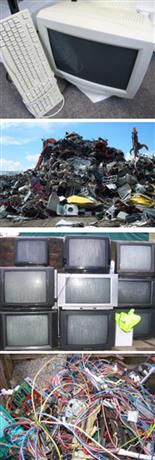
STOP! Don’t put electrical equipment in the bin.
Play your part in protecting the environment!
The fact that you are reading this means that you are interested in looking after the environment and want to know more about the safe disposal of electrical items once you’ve finished with them. Here, we give you more information about the problems associated with dumping electrical items into landfill and what the UK has implemented to turn this situation around and make the environment a safer place. We also have a search facility available to help you find your nearest recycling point.
Waste Electrical and Electronic Equipment - WEEE.
Back in the early 90’s, the world’s nations came together for the Rio Earth Summit and decided that something needed to be done about some of the more difficult waste streams entering landfill sites and one of these waste streams was electrical and electronic equipment.
The UK now has legislation in place with the objective of diverting as much WEEE as possible to be reused or recycled. The regulations are known as
“The Waste Electronic and Electrical Equipment Regulations.”
Our environment needs YOU!
We throw away a million tonnes of household electrical and electronic waste every year in the United Kingdom. And that’s just household waste! At least as much comes from non-household sources such as offices, factories, schools and hospitals.
Waste electrical and electronic equipment (WEEE) is one of the fastest growing waste streams in the UK and the EU.
Some EEE (Electrical and electronic equipment) contains hazardous substances and parts such as;
• mercury in some switches,
• lead in solder,
• cadmium in batteries.
Heavy metals are particularly harmful to the environment because they accumulate through the food chain and can cause serious health effects in humans.
Other items are also potentially damaging such as plasticizers which can leach into the soil caused toxicity in wildlife.
Apart from that there have been several cases of electrical waste being sent abroad to be recycled in less than favorable conditions. The UK wishes to reduce these effects and better manage the way items are recycled.
Recycling and recovery also means that less raw materials, materials taken from the ground such as ores and oil etc, are needed to make new items. This is an extremely important way of reducing the carbon emissions which contribute to climate change.
Why separate WEEE from other waste?
By keeping WEEE separate from other waste it can be treated, the hazardous substances can be removed and a large amount of waste can be recycled rather than sent to landfill. Thus reducing the 6 million tonnes of WEEE produced each year by the EU alone!
When does this apply to me?
From the 1st of July 2007, producers and retailers of electrical equipment need to have in place a system for the collection, reuse and recycling of household waste electrical items. As an end user of such equipment you can take advantage of new collection facilities that are available.
What to look for…
All products covered by the regulations include those that need electricity for their main function. They will ALL be marked with the crossed out wheelie bin symbol shown below.

What does this mean for YOU?
We would encourage you to not put your redundant equipment into the bin but look instead to recycle it.
I’m a business - What can I do with my waste electrical equipment?
If you have a household electrical item such as a kettle, toaster, microwave etc and you wish to buy a replacement, ask your retailer for details of their take-back scheme. The retailer will either take it back in store or they may direct you to a local designated collection facility (DCF).
If you have non-domestic electrical equipment to dispose of, your retailer has no obligation to take it back. You will need to find a local collector or waste company to take your waste.
I’m a householder - What can I do with my waste electrical equipment?
If you have a household electrical item such as a kettle, toaster, microwave etc and you wish to buy a replacement, ask your retailer for details of their take-back scheme. The retailer will either take it back in store or they may direct you to a local designated collection facility (DCF). Many councils have facilities to collect and recycle electrical equipment. Use our search facility to find your nearest site.
It will be easier to recycle your old equipment!
Through improved local authority civic amenity (CA) sites or new take-back facilities provided by retailers.
Householders can:
• take old appliances to their local CA site;
• arrange for their local authority to collect the equipment (Beware! There may be a charge for this!)
• arrange for an electrical retailer delivering new equipment to take away the old appliance.